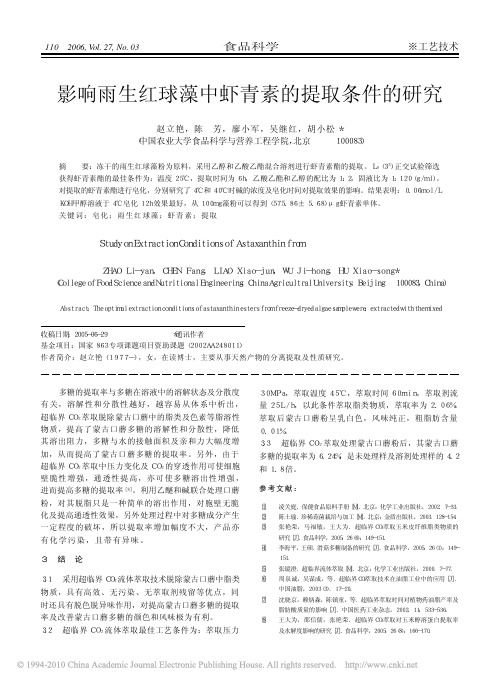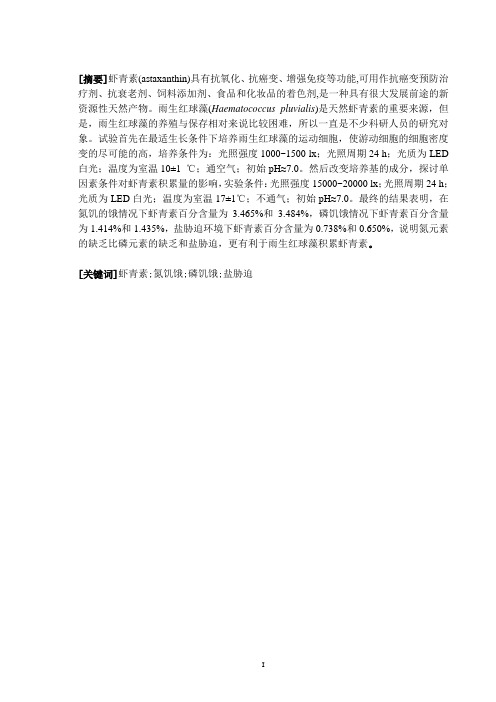雨生红球藻培养生产天然虾青素项目环境影响报告书
- 格式:doc
- 大小:942.00 KB
- 文档页数:97


生产虾青素的雨生红球藻藻株及其培养基筛选吴晓娟;唐小平;苏艳秋;罗国强【摘要】In order to gain the suitable algae and culture medium for astaxanthin production,the influence of culture medium on the cell growth and astaxanthin accumulation of Haematococcus pluvialis were studied and compared.Three strains of Haematacoccus pluvialis (H2,H3 and H4) were cultured in four different media (BBM,BBM+1 g/L NaAC,SM andBG11).The results showed that the SM medium was benefit for the growth and biomass accumulation of Haematacoc-cus pluvialis.In the same medium,the growth rate was faster in H3 than H2 and H4.In all experimental groups,the strain H3 had the fastest growth rate and biomass accumulation rate in the medium SM,and had the highest astaxanthin content (2.17%)and astaxanthin yield(30.1 mg/L)in BBM+1 g/L NaAC medium,reaching 1.16~4.72 times(P<0.05)and 1.18~6.28 times(P<0.01)of those of other experimental groups,respectively.So,the strain H3 was fit for large scale cultivation, and its optimal medium for growth and astaxanthin accumulation were SM and BBM+1 g/L NaAC,respectively.%为筛选获得适合大规模生产虾青素的藻株及适宜其生长和虾青素积累的培养基,研究比较了3个不同品系的雨生红球藻H2、H3、H4在4种不同培养基BBM、BBM+1 g/L NaAC、SM、BG11中的生长和虾青素积累情况。

虾青素(Astaxanthin),即3,3’-二羟基-4,4’-二酮基-β,β’-胡萝卜素,分子式为C40H52O4,相对分子质量为596,其结构式如下(其中R= CH3)。
呈鲜红色,在水生动物、鸟类羽毛及植物叶、花、果中广泛存在,具有极强的抗氧化、抗癌变、增强免疫作用的功能。
一虾青素的生理功能虾青素可淬灭单线态氧,清除自由基,阻止脂质过氧化,保护机体免受伤害, 预防癌症发生,还能促进人体免疫球蛋白的产生,具有更高的免疫调节活性。
研究表明,虾青素具有抗氧化活性的类胡萝卜素,虾青素的抗氧化性比β-胡萝卜素高约10倍,比维生素E高约500倍。
虾青素已被认为是“超级维生素E”。
体外细胞培养试验研究虾青素对鼠免疫活性细胞的繁殖及功能的影响,结果显示虾青素比裸藻酮和β-胡萝卜素具有更高的免疫调节活性。
最新研究表明,虾青素具有比β-胡萝卜素更强的抑制癌变的能力。
二虾青素的商业开发由于动物本身不能够合成虾青素,而且绝大部分动物也不能把其他类胡萝卜素转化成虾青素,因此必须从食物中摄取虾青素。
目前虾青素已经在美国被批准为食品添加剂,并且在三文鱼的养殖中得到了很好的应用。
现在市场上虾青素的售价很高,单价达2000-2500美元每公斤(虾青素含量3%),而虾青素软胶囊每瓶140元,每瓶虾青素总量为360mg。
在2000年,虾青素的市场容量估计就已经达到了每年2亿美元。
因此进一步研究虾青素对人体的作用,开发相关的保健品和保健化妆品,则可以扩大天然虾青素的应用范围和市场。
三虾青素的来源虾青素主要有两种生产方式,即化学合成和天然提取。
一)化学合成虾青素化学合成法要经过多步化学和生物催化反应才能完成,其化学合成的前体物质为(S-3-乙酸基-4-氧代-β-紫罗酮,它是不同的微生物对(R)萜烯醇醋酸盐不对称水解,经过萃取,反流分布及重结晶等技术处理而得到产物。
人工合成的虾青素大多为顺式结构,而生物体合成的虾青素大多为反式结构。
动物体对人工合成的虾青素吸收能力较弱,而且人工合成的虾青素的着色能力和生物效价远比天然虾青素低。



[摘要]虾青素(astaxanthin)具有抗氧化、抗癌变、增强免疫等功能,可用作抗癌变预防治疗剂、抗衰老剂、饲料添加剂、食品和化妆品的着色剂,是一种具有很大发展前途的新资源性天然产物。
雨生红球藻(Haematococcus pluvialis)是天然虾青素的重要来源,但是,雨生红球藻的养殖与保存相对来说比较困难,所以一直是不少科研人员的研究对象。
试验首先在最适生长条件下培养雨生红球藻的运动细胞,使游动细胞的细胞密度变的尽可能的高,培养条件为:光照强度1000~1500 lx;光照周期24 h;光质为LED 白光;温度为室温10±1 ℃;通空气;初始pH≈7.0。
然后改变培养基的成分,探讨单因素条件对虾青素积累量的影响,实验条件:光照强度15000~20000 lx;光照周期24 h;光质为LED白光;温度为室温17±1℃;不通气;初始pH≈7.0。
最终的结果表明,在氮饥的饿情况下虾青素百分含量为3.465%和3.484%,磷饥饿情况下虾青素百分含量为1.414%和1.435%,盐胁迫环境下虾青素百分含量为0.738%和0.650%,说明氮元素的缺乏比磷元素的缺乏和盐胁迫,更有利于雨生红球藻积累虾青素。
[关键词]虾青素;氮饥饿;磷饥饿;盐胁迫Abstract:Astaxanthin has antioxidant, anticancer and function of enhancing immune. It can be used as anti-cancer prevention and treatment agent, anti-aging agent, feed additive and coloring agents of food and cosmetic. So it is a kind of promising “new resources of food”. With the rapid development of medicine industry, food industry and aquaculture, the demand for Astaxanthin will must grow. In the experiment, the green movement cells of Haematococcus pluvialis were cultivated under optimal growth conditions in order to obtain maximum biomass. The conditions of culture were as following: light intensity was 1000~1500 lx; light cycle was 24 h; light quality was white; temperature was 10±1℃ and pH was about 7.0. Then the components of culture medium were changed for investigation on the effect of single factor on astaxanthin accumulation. The final results show that in the same external conditions, the lack of nitrogen was more conducive than those of phosphorus and salt stress to the accumulation of astaxanthin in Haematococcus pluvialis.Key word:Astaxanthin, Nitrogen starvation, Phosphorus starvation, Salt stress.目录1 前言............................................................ - 1 - 1.1雨生红球藻 .. (1)1.1.1 雨生红球藻形态及分类学特点 ................................ - 1 -1.1.2雨生红球藻生活周期......................................... - 1 -1.1.3雨生红球藻培养............................................. - 2 -1.1.4外界环境对雨生红球藻生长的影响............................. - 2 - 1.2虾青素. (2)1.2.1虾青素的化学特征及来源..................................... - 2 -1.2.2雨生红球藻细胞内虾青素合成及积累........................... - 3 -1.2.3外界环境对虾青素合成的影响................................. - 4 -1.2.4虾青素的生理功能及实际应用................................. - 4 -2 试验材料与方法.................................................... - 6 - 2.1主要试验材料 (6)2.1.1 藻种 ...................................................... - 6 -2.1.2 主要试验试剂 .............................................. - 6 -2.1.3主要试验仪器与设备......................................... - 6 - 2.2试验方法.. (7)2.2.1雨生红球藻的培养........................................... - 7 -2.2.2雨生红球藻的生长检测....................................... - 7 -2.2.3虾青素的积累............................................... - 7 -2.2.4虾青素含量的检测........................................... - 7 -3 试验内容.......................................................... - 8 - 3.1雨生红球藻的培养 .. (8)3.1.1 培养基的配置 .............................................. - 8 -3.1.2 试验材料的灭菌 ............................................ - 8 -3.1.3接种....................................................... - 9 -3.1.4培养....................................................... - 9 -3.1.5生长检测.................................................. - 10 - 3.2诱导虾青素.. (11)3.3虾青素含量的测定 (12)4 结果与讨论....................................................... - 13 - 结论............................................................. - 18 - 参考文献........................................................... - 19 - 致谢.................................................. 错误!未定义书签。
本技术公开了非连续性两步法培养雨生红球藻生产虾青素的方法,在室内培养和室外诱导培养之间,增加如下步骤:步骤一、改变培养条件,将室内培养得到的雨生红球藻游动营养细胞转变为不动营养细胞;步骤二、收集并浓缩步骤一中所得藻液,加入抗生素和/或防腐剂,低温冷藏;步骤三、除去冷藏后的藻液中的抗生素和/或防腐剂,加入稀释的培养基,在弱光照条件下通气培养,对所述不动营养细胞进行活化。
本技术的方法能够在室外诱导培养中断的情况下,将室内培养的营养细胞进行浓缩储藏,在气候适宜的时候,将储藏的营养细胞快速活化并进行室外诱导培养,以大幅缩短整体培养周期,提高设备利用率和生产率,从而提高生产的稳定性。
权利要求书1.非连续性两步法培养雨生红球藻生产虾青素的方法,其特征在于,在室内培养和室外诱导培养之间,增加如下步骤:步骤一、改变培养条件,将室内培养得到的雨生红球藻游动营养细胞转变为不动营养细胞;步骤二、收集并浓缩步骤一中所得藻液,加入抗生素和/或防腐剂,低温冷藏;步骤三、除去冷藏后的藻液中的抗生素和/或防腐剂,加入稀释的培养基,在弱光照条件下通气培养,对所述不动营养细胞进行活化。
2.如权利要求1所述的非连续性两步法培养雨生红球藻生产虾青素的方法,其特征在于,所述室内培养具体为:将雨生红球藻藻种置于BG11培养基中进行培养,初始接种量为5~30万个细胞/ml,培养温度为15~25℃,白色荧光灯24小时连续单侧光照,光照强度为50~100μE/m2/s,pH为7.0~8.0,培养7~15天,游动营养细胞比例为80~100%。
3.如权利要求1所述的非连续性两步法培养雨生红球藻生产虾青素的方法,其特征在于,所述步骤一,具体为:将室内培养的温度提升至28-35℃和/或将pH提高至8.5-9.5,继续培养1-5天,当90%以上游动营养细胞转变为不动营养细胞时,停止培养。
4.如权利要求3所述的非连续性两步法培养雨生红球藻生产虾青素的方法,其特征在于,所述步骤二,具体为:将步骤一中所得藻液进行沉降浓缩后,离心,去除上清液,向所得藻泥中加入防腐剂溶液和/或抗生素溶液,震荡混匀,在4℃下进行储藏,储藏周期为2~12周,其中,所述防腐剂溶液和/或抗生素溶液用灭菌水配制,经过滤除菌后,再加入所述藻泥中,所述防腐剂溶液和/或抗生素溶液为乳酸链球菌素溶液、纳他霉素溶液、ε-聚赖氨酸溶液、卡那霉素溶液、硫酸庆大霉素溶液以及山梨酸钾溶液中的一种或几种的混合液。
2022年高考生物真题呼吸作用和光合作用(2022新课标II卷,3)下列与微生物呼吸有关的叙述,错误..的是()A.肺炎双球菌无线粒体,但能进行有氧呼吸B.与细菌呼吸有关的酶由拟核中的基因编码C.破伤风芽孢杆菌适宜生活在有氧的环境中D.有氧和无氧时,酵母菌呼吸作用产物不同【答案】C(2022新课标II卷,2)关于叶绿素的叙述,错误..的是()A.叶绿素a和叶绿素b都含有镁元素B.被叶绿素吸收的光可用于光合作用C.叶绿素a和叶绿素b在红光区的吸收峰值不同D.植物呈现绿色是由于叶绿素能有效地吸收绿光【答案】D(2022安徽卷,3)右图为每10粒水稻种子在成熟过程中于物质和呼吸速率变化的示意图。
下列分析不正确...的是A.种子干物质快速积累时期,呼吸作用旺盛B.种子成熟后期自由水减少,呼吸速率下降C.种子成熟后期脱落酸含量较高,呼吸速率下降D.种子呼吸速率下降有利于干物质合成【答案】D(2022大纲卷,31)某研究小组测得在适宜条件下某植物叶片遮光前吸收CO2的速率和遮光(完全黑暗)后释放CO2的速率。
吸收或释放CO2的速率随时间变化趋势的示意图如下(吸收或释放CO2的速率是指单位面积叶片在单位时间内吸收或释放CO2的量),回答下列问题:(1)在光照条件下,图形A+B+C的面积表示该植物在一定时间内单位面积叶片光合作用,其中图形B的面积表示,从图形C可推测该植物存在另一个的途径,CO2进出叶肉细胞都是通过)的方式进行的。
(2)在上述实验中,若提高温度、降低光照,则图形(填“A”或“B”)的面积变小,图形(填“A”或“B”)的面积增大,原因是。
【答案】(1)固定的CO2总量呼吸作用释放出的CO2量释放CO2 自由扩散(2)A B 光合速率降低,呼吸速率增强(2022新课标Ⅰ卷,29)(11分)某油料作物种子中脂肪含量为种子干重的70%。
为探究该植物种子萌发过程中干重及脂肪的含量变化,某研究小组将种子置于温度、水分(蒸馏水)、通气等条件适宜的黑暗环境中培养,定期检查萌发种子(含幼苗)的脂肪含量和干重,结果表明:脂肪含量逐渐减少,到第11d时减少了90%,干重变化如图所示。
雨生红球藻中虾青素的提取和稳定性研究刘铁楠;吴春涛;苏鹏宇;李素新;张志婓【摘要】Objective To study the conditions and stability of astaxanthin extracted by organic solvent, taking Haema-tococcus pluvialis as raw materials. Methods The ethyl acetate, acetone, methylene chloride, absolute ethyl alcohol and methylene chloride : acetone (2:1) were selected as extraction solvent by experiments, the effect of different extraction solvents for extraction of astaxanthin was studied; the optimum solvent gained from the experiment was used to extract astaxanthin at 20, 30, 40, 50, 60, 70, 80℃, so as to determine the optimum extraction temperature; under the gained optimum temperature and solvent, the astaxanthin was extracted for 1, 1.5, 2, 2.5, 3 h respectively, so as to determine the optimum extraction time;the extraction times were set as 1, 2, 3 times, OD480 was measured after extraction, so as to study the effect of extraction times for extraction of astaxanthin; under the gained optimum solvent, temperature and time in the above experiments, the ratios of material to solvent were taken as 1:5, 1:10, 1:15, 1:20, 1:25, 1:30, 1:35, 1:40, OD480 was measured after extraction, so as to investigate the effect of different ratios of material to solvent for extraction of astaxanthin. The stability of astaxanthin was researched, and the absorbance of astaxanthin extracting solution was determined at different conditions of light (natural light, sunlight, lucifuge), temperature (30, 40, 50, 60, 70, 80℃), acid-base (pH 8-14), and so on. Results In the extraction of astaxanthin, thesecondary extraction can obtain 90% of astaxanthin. When the ratio of material to solvent was 1:25, the measured absorbance was maximum. Methylene chlo-ride:acetone (2:1) was the best extracting solution. The degradation of astaxanthin increased with the increase of light in-tensity and the increase of alkali concentration. Below 60℃, the effect of temperature on astaxanthin was small. Above 60℃, astaxanthin began tobe heated and damaged. Conclusion Methylene chloride : acetone (2:1) is best extracting solution, and 1:25 is the best ratio of material to solvent.the secondary extraction can extract most of astaxanthin, light can lead to degradation of astaxanthin, astaxanthin is unstable to alkali, astaxanthin is relatively stable b elow 60℃.%目的:以雨生红球藻为原料,研究有机溶剂提取虾青素的条件及其稳定性。